This article relies largely or entirely on a single source .(May 2013) |
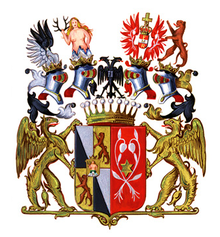


The House of Clam-Martinic is the name of an old and influential noble family, whose family members occupied many important positions within the Habsburg Empire.
This article relies largely or entirely on a single source .(May 2013) |



The House of Clam-Martinic is the name of an old and influential noble family, whose family members occupied many important positions within the Habsburg Empire.
The family originates from Berg near Henndorf am Wallersee and appeared under the name Berger or Pörger (Perger), Edle Herren von Höchenperg. Around 1209 a Carinthian branch owned Höhenbergen castle near Völkermarkt. In 1524, the family acquired Clam Castle in Upper Austria, which to this day is owned by the family.
This line was established when Carl Josef, Count of Clam (1760-1826), a member of an old Austrian noble Clam family, married Maria Anna, Countess of Martinic (z Martinicz or Martinicové in Czech) (1768-1832), a member of an old Bohemian noble family claimed to be descended from the Vršovci family. [1] The other line of the Clam family, namely Counts of Clamm und Gallas, owners of the Frýdlant castle, whose other possessions were mostly in Bohemia, died out in 1930.
Czech nobility consists of the noble families from historical Czech lands, especially in their narrow sense, i.e. nobility of Bohemia proper, Moravia and Austrian Silesia – whether these families originated from those countries or moved into them through the centuries. These are connected with the history of Great Moravia, Duchy of Bohemia, later Kingdom of Bohemia, Margraviate of Moravia, the Duchies of Silesia and the Crown of Bohemia, the constitutional predecessor state of the modern-day Czech Republic.

The Austrian nobility is a status group that was officially abolished in 1919 after the fall of Austria-Hungary. Austria's system of nobility was very similar to that of Germany, as both countries were previously part of the Holy Roman Empire (962–1806).

The House of Hohenlohe is a German princely dynasty. It formerly ruled an immediate territory within the Holy Roman Empire, which was divided between several branches. In 1806, the area of Hohenlohe was 1,760 km² and its estimated population was 108,000. The motto of the house is Ex flammis orior. The Lords of Hohenlohe were elevated to the rank of Imperial Counts in 1450, and from 1744, the territory and its rulers were princely. In 1825, the German Confederation recognized the right of all members of the house to be styled as Serene Highness, with the title of Fürst for the heads of its branches, and the title of prince/princess for the other members. From 1861, the Hohenlohe-Öhringen branch was also of ducal status as dukes of Ujest.

The House of Thun und Hohenstein, also known as Thun-Hohenstein, belonged to the historical Austrian and Bohemian nobility. There is one princely and several comital branches of the family. The princely branch of the family lived at Děčín in Bohemia for more than 200 years. The family maintained an album of artistically and technologically innovative armour throughout the fifteenth and sixteenth centuries.
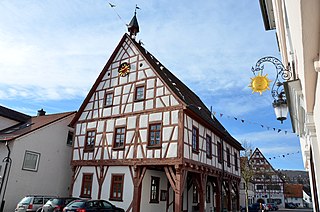
Schelklingen is a town in the district of Alb-Donau in Baden-Württemberg in Germany. It is situated 10 km north of Ehingen, and 20 km west of Ulm. Schelklingen and 82% of its territory form part of the Swabian Jura Biosphere Reserve.

The House of Harrach is the name of an old and influential Austro-German noble family, which was also part of the Bohemian nobility. The Grafen (Counts) of Harrach were among the most prominent families in the Habsburg Empire. As one of a small number of mediatized houses, the family belongs to the High nobility.

The House of Bibra was one of the leading Uradel families in Franconia and present day Thuringia from the mid-15th century to about 1600. Later on the family rose from Reichsritter to Reichsfreiherr. After the Holy Roman Empire dissolved, they were made ‘’Freiherr’‘ (Barons) of Bavaria and Bohemia.

Count Jindřich Matyáš of Thurn-Valsassina, was one of the leaders of the Protestant Bohemian Revolt against Emperor Ferdinand II. He took part in events that led to the Thirty Years' War, and after the war he became a military leader and diplomat in Swedish service, who eventually resided in Swedish Estonia.

Alfred III, Prince of Windisch-Grätz was a Bohemiann and Austrian nobleman, an Austro-Hungarian statesman who served as 11th Minister-President of Austria between 1893 and 1895, replacing Eduard Taaffe, 11th Viscount Taaffe, who previously held this position for 14 straight years.

The House of Waldstein or House of Valdštejn is a Bohemian noble family that originated from the Kingdom of Bohemia as a branch of the Markwartinger family and gained prominence during the reign of the Přemyslid dynasty. The house was founded by Jaroslav of Hruštice (1234–1269) and named after Valdštejn Castle near Turnov in northern Bohemia. The family's most prominent members include Albrecht von Wallenstein, the Imperial general during the Thirty Years' War, and Ferdinand Ernst von Waldstein, a statesman and early patron of Ludwig van Beethoven.
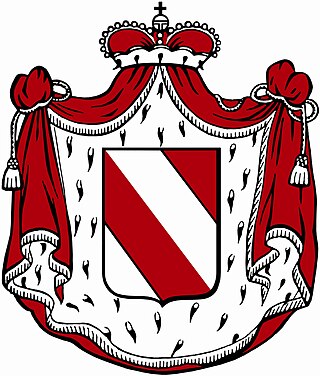
The House of Schönburg is an old European noble family of princely and historically sovereign rank. It formerly owned large properties in present-day Saxony, Thuringia and Bohemia. As a former ruling and mediatized family, it belongs to the Hochadel. The family today includes two princely and a comital branch.
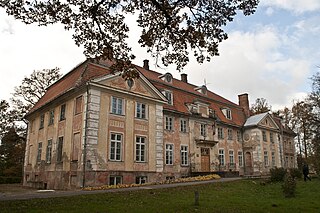
Ozolmuiža Manor is an Early Classicism style manor house built for Count George Johann von Mellinn at the end of the 18th century in the historical region of Vidzeme, northern Latvia.

Countess Auguste von Harrach zu Rohrau und Thannhausen, Princess of Liegnitz, was the second wife of King Frederick William III of Prussia. At the time of their marriage, the House of Harrach was still not recognized as equal for dynastic purposes. Later, in 1841, a year after Frederick William's death, they were officially recognized as a mediatized family, with the style of Illustrious Highness, which allowed them to officially have equal status for marriage purposes to those reigning and royal families. Thus, in 1824 when the marriage occurred, it was treated as morganatic, so she was not named Queen, but was given the title Princess von Liegnitz and Countess von Hohenzollern. Frederick reportedly stated that he did not wish to have another queen after Queen Louise.

The House of Orsini-Rosenberg is the name of an old Austrian noble family. The family is mediatized and as such belongs to the high nobility. It originally sprang out from the Graben family from Castle Alt-Grabenhofen near the city of Graz.

The House of Khevenhüller is the name of an old and important Carinthian noble family, documented there since 1356, with its ancestral seat at Landskron Castle. In the 16th century, the family split into the two branches of Khevenhüller-Frankenburg, Imperial Counts from 1593, and Khevenhüller-Hochosterwitz, raised to Imperial Counts in 1725 and, as Khevenhüller-Metsch, to princely rank (Fürsten) in 1763. The family was mediatised therefor belongs to high nobility.
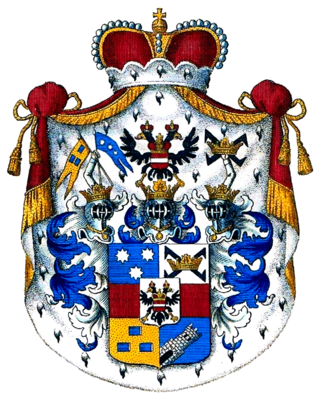
The House of Clary und Aldringen, also known as Clary-Aldringen, is one of the most prominent Austro-Hungarian princely families. Originally from Friuli, Northern Italy, one branch of the family moved to the County of Tyrol around 1500 and to the Kingdom of Bohemia around 1600, where it became one of the leading families of the Bohemian nobility. It produced several notable Austro-Hungarian statesmen, military officers and diplomats.

The Martinic family or House of Martinice was a Bohemian noble family, claimed to be descended from the old Vršovci clan. The family have been part of the Bohemian ancient nobility. As of 1322, the family possessed the castle Martinice near Votice in the southern part of Central Bohemia. Members include Jaroslav Bořita of Martinice, who was victim of the 1618 Defenestration of Prague.

The House of Rapperswil respectively Counts of Rapperswil ruled the upper Zürichsee and Seedamm region around Rapperswil and parts of, as of today, Swiss cantons of St. Gallen, Glarus, Zürich and Graubünden when their influence was most extensive around the 1200s until the 1290s. They acted also as Vogt of the most influential Einsiedeln Abbey in the 12th and 13th century, and at least three abbots of Einsiedeln were members of Rapperswil family.

The House of Schallenberg is the name of an old and important Austro-Hungarian noble family, whose members occupied may important political positions and were in diplomatic service.
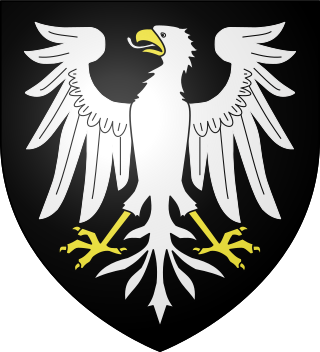
The Arnstein family was a noble family from the Saxony-Anhalt region in Germany.